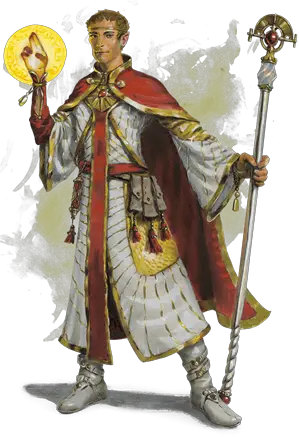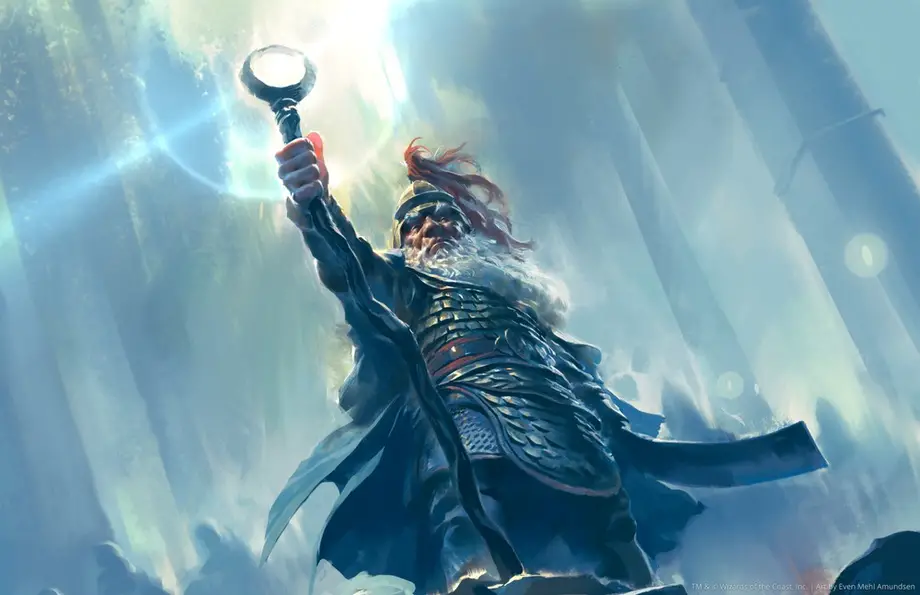Turn Undead is one of the most important features in the Cleric’s kit. After all, there are plenty of undead enemies who prefer to swarm parties of adventurers!
Taken on their own, these creatures tend to be weak. But when you’re facing down a group of ten, twenty, fifty, or even more of them…
Well, let’s just say things aren’t exactly ideal in those situations…
So today we’re looking over the Turn Undead / Destroy Undead feature!
Specifically, we’ll cover how this works, look at situations where you’ll want to use it, and answer some common questions.
This isn’t a feature that you’ll be using all the time unless your campaign is heavily focused on undead enemies. But when you need it, you’ll want to know exactly how it works!
Let’s dive in!
How Does Turn Undead Work in D&D 5e?
Turn Undead is a feature gained by Clerics in D&D 5e when they hit level 2.
It’s worth mentioning that Oath of Devotion Paladins get a feature called “Turn the Unholy” that works similarly to Turn Undead.
The features are mostly the same, though Turn the Unholy also works against fiends (like demons and devils).
Other Paladin subclasses with similar “turn” effects are the Oath of the Ancients Paladin and the Oath of the Watchers Paladin.
Clerics, on the other hand, will eventually get an upgraded version of Turn Undead that outright destroys undead enemies.
So, there’s a bit of a trade-off. However, the “turning” effect works the same for both. I’ll mention any points in this article where they might differ.

Using Turn Undead in D&D 5e
For Clerics, using Turn Undead costs one use of their Channel Divinity.
Keep in mind that you regain uses of your Channel Divinity on a short rest as a Cleric. If you’ve just fought off a zombie horde, it’s worth taking a short rest to catch your breath and recover your Channel Divinity slots.
| Cleric Level | Number of Channel Divinity Uses |
| 1 – 5 | 1 |
| 6 – 17 | 2 |
| 18 + | 3 |
Paladins use their “turn” features with their Channel Divinity as well.
As with Clerics, they regain this use on a short or long rest. However, Paladins only have one use of Channel Divinity per rest, so you’ll want to make it count!
In both cases, using Channel Divinity takes an action.
You will also need to have your Holy Symbol on you and not be affected by any silencing effects. Presenting your Holy Symbol and saying a prayer are a part of using this feature.
When you use your Channel Divinity this way, enemies within 30 feet of you that can see/hear you must make a Wisdom saving throw or be “turned.” (We’ll cover what that means in just a moment.)
The DC for Turn Undead is the same as your Cleric spell save DC:
Cleric Spell Save DC = 8 + Proficiency Bonus + Wisdom Modifier
Turn the Unholy (and other similar effects for Paladins) uses the Paladin’s spell save DC:
Paladin Spell Save DC = 8 + Proficiency Bonus + Charisma modifier

The Turned Effect
When a creature has been “turned” by Turn Undead or a similar effect, they are forced to flee.
Specifically, the creature must spend its turns moving as far away from you as possible. It also cannot willingly move to a space within 30 feet of you.
The turned creature must take the Dash action on their turn to get away. If they are restrained or otherwise can’t move, they can instead try to escape whatever is preventing them from moving.
But let’s say for example that you’re blocking the only entrance/exit to a room full of turned undead. They can’t escape since they can’t move closer to you and the room’s exit.
In that case, the turned creatures would take the Dodge action.
Related: Explaining Actions & Combat in D&D 5e
Finally, a turned creature can’t take reactions.
Keep in mind that this means they won’t be able to make any attacks of opportunity. If your party was getting surrounded, this is a great time for the party to group up and decide if they want to fight or flee.
The “turn” effect lasts for 1 minute or until the affected creature takes damage.
Note that this damage can come from any source. Be mindful of any environmental hazards that might cause them to take damage and end the effect!
If your party decides to fight enemies that have been turned, be strategic and focus down the biggest threats one at a time!

When to Use Turn Undead
The point of Turn Undead is to get you out of situations in which you’ve been overrun by undead enemies. It’s at its best when you’re getting swarmed.
Zombies, skeletons, ghouls, and other undead enemies that like to swarm the party are particularly humbled by Turn Undead.
Like I mentioned earlier, a zombie or two on their own isn’t much to worry about beyond the first couple of levels. But a big enough horde of zombies, skeletons, or similar creatures can be a threat at pretty much any tier of play.
But you don’t have to save it for situations that look like they came straight out of The Walking Dead. Sometimes it’s the best way to lock down a particularly troublesome enemy.
While Turn Undead makes for excellent crowd control, don’t hesitate to use it against a particularly troublesome undead enemy like a specter, a screaming banshee, or a bodak.
Turn Undead will usually also work on stronger undead creatures like Vampires, Liches, and Mummy Lords. However, undead like these are commonly encountered as boss enemies and might have extra resistances.
Just keep in mind that it lasts for 1 minute or until the creature takes damage.
If things are getting particularly bad, that 1 minute might be enough time to buy you some time to run. Just know that the second it wears off, those enemies are likely to start chasing you again!
But 1 minute is plenty of time in combat. That’s effectively 10 rounds where the enemies aren’t able to get near you unless they take damage.
If you take this opening to coordinate as a party and choose your targets strategically, it’s incredibly powerful. Enemies will be helpless as you take them off the initiative counter one by one!

How Does Destroy Undead Work in D&D 5e
At level 5, Clerics get an upgrade for their Turn Undead feature.
Depending on the challenge rating of undead creatures that fail their save against Turn Undead, you might just outright destroy them!
| Cleric Level | Destroys Undead of CR |
| 5 | 1/2 or lower |
| 8 | 1 or lower |
| 11 | 2 or lower |
| 14 | 3 or lower |
| 17 | 4 or lower |
Destroy Undead doesn’t require anything extra from you. It has the same range and save DC as Turn Undead.
Let’s be real, the ability to potentially nuke every undead creature within 30 feet of you is pretty awesome. Being able to do so up to three times per short rest (at level 20) is just purely epic!

FAQs – Turn Undead and Destroy Undead in D&D 5e
Before we wind down, I want to take a moment to answer some common questions I’ve seen asked about Turn Undead in D&D 5e.
As always, let me know in the comments if you still have any questions!
Does Turn Undead require Concentration?
Turn Undead does not require your concentration.
This means that you can still safely use this alongside powerful spells like Spirit Guardians and Spiritual Weapon.
Additionally, you don’t have to worry about all of those turned creatures running back towards you simply because you got hit by another creature and failed a concentration check!
If a creature fails its saving throw, it’s turned until it takes damage or one minute passes!
Is Turn Undead a Bonus Action?
Turn Undead requires your Channel Divinity feature to use which means it takes an action.
In situations where it applies, you will typically want to use it. However, it’s still a good idea to plan your turn accordingly.
In some situations, it might be better to cast a spell. Such moments are rare when you’re facing groups of undead, but they do happen.
I’d recommend checking out my article that covers Action Economy in D&D 5e to help you learn how to make the most of your turns!

Does Turn Undead End Possession?
Some undead enemies like Ghosts can possess others. Needless to say, it’s a pretty terrible and terrifying experience for everyone.
To end a possession, one of three things would need to happen:
- The “host” body drops to zero hit points.
- The ghost voluntarily leaves the “host” body.
- You manage to force the ghost out.
The first option is unpleasant and relies on you taking down an ally. Meanwhile, the second option can be very difficult to arrange.
Thankfully, Turn Undead is a very reliable way to force out an undead spirit that is possessing someone.
If you think you can reason with the ghost, option 2 is the ideal situation since it won’t consume any resources. But if the ghost can’t be reasoned with, don’t hesitate to bust out that Holy Symbol and make them run (float?) away screaming!
In most cases, turning whatever is possessing your ally should be sufficient.
While there are some types of possession that go beyond this, they are very rare and outside the scope of this article.
If you’d like to see an article all about possession, let me know in the comments!
Is Turn Undead a magical effect?
A lot of confusion exists on whether Turn Undead is a magical effect.
This mostly stems from enemies like Flameskulls that have Magic Resistance which gives them advantage on saving throws against spells and other magical effects.
So, while Turn Undead is a feature and not a spell (which means it can’t be counterspelled), its effect is still magical in nature.
My thinking here is that the entry in the Player’s Handbook (page 58) specifically says that Channel Divinity “[uses] that energy to fuel magical effects.”
This would also apply to other “turn” effects like Paladins’ Turn the Unholy feature.
Conclusion – Turn Undead in D&D 5e
I hope this article has helped you!
Clerics have a ton of features and spells that are just simply iconic. However, I don’t think they get much more iconic than Turn Undead!
Fortunately, every Cleric gets the Turn Undead / Destroy Undead feature with their Channel Divinity in addition to the options they gain from their subclass.
You can check out my full ranking of every Cleric subclass in D&D 5e here!
Want all the latest player guides, DM tips, news, reviews, and more for D&D 5e? Sign up for the Tabletop Joab newsletter below!
You can also follow me on Facebook and Twitter.
If you found this article helpful and want to support the site, you can buy me a coffee here! (It’s not expected, but very appreciated!)









